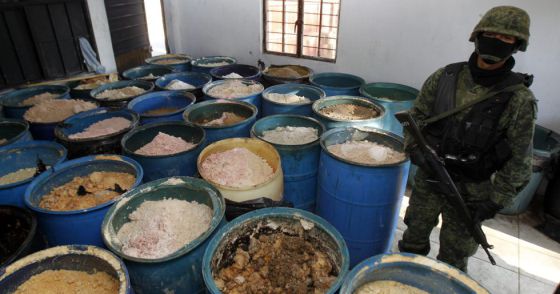
Leaders of Colombia, Brazil, Guatemala, El Salvador and Mexico have made a call to the United States. For the first time, they are appealing for regulation of the drug trade.
The critical level of violence caused by the Latin American drug trade has incited the old legalization debate for the first time in the agenda of current presidents. Leaders of Guatemala and El Salvador, Otto Perez and Mauricio Funes, have called to examine the option of regulating the commercial drug trade. Costa Rican president Laura Chinchilla has accepted the challenge, saying that she would not oppose a “serious and rigorous” debate. These pronouncements from Central American leaders have furthered the discourse opened in November by Colombian president Juan Manuel Santos, who came out as a supporter of marijuana and cocaine legalization if it would “eradicate drug-related violence.” They have also entrenched the first decisive governmental front against the policy of the prohibition imposed tooth-and-nail by the United States.
The seed of regulation began to germinate with the joint declaration made by Perez and Funes this past Monday, Feb. 13. The media coverage of the issue has grown so much that even the administration of Felipe Calderon, with five months left in his term, has accepted the idea of putting the issue on the table. Throughout the bloody six years that he has governed Mexico, he has been the main defender of the U.S.’ strategy of strong-arm criminalization. His Secretary of Foreign Affairs, Patricia Espinosa, admitted this Wednesday that it is necessary to advance the debate to “an international level.”
This incipient tide of change among Latin American leaders has in turn strengthened the solid regulationist movement started by previous leaders. With no elections at stake, they are attacking head-on the model imposed by the United States, the political and economic sponsor of the countries most devastated by the drug trade. “Their policy has failed,” former Brazilian president Fernando Henrique Cardoso said several days ago at the Drugs Forum in Mexico City. Cesar Gaviria, ex-president of Colombia and one of Cardoso’s colleagues in the Global Commission on Drug Policy (the center of debate among international leaders), spoke at length at the same conference. Criticizing Washington’s refusal to outline a new policy model, he asked “Are we going to continue to allow people to die because they’re not capable of discussing the problem?”
Murders and institutional corruption extend throughout the north of South America, the main area of production, and the United States, the world capital of consumption. Central America and Mexico, the intermediate regions that accommodate the trafficking routes, are being incrementally destroyed.
El Salvador and Guatemala hold the second and seventh places on the UN’s list of countries by homicide rate, published in 2011 using statistics from 2010. That year, 66 out of every 100,000 Salvadoreans were murdered, along with 41 of every 100,000 Guatemalans. The focus, however, is on Mexico. Though numerically lower, the bloodshed is of immeasurable proportions. In the last six years, according to official data, there have been 47,500 civilian deaths from drug-related crimes. The homicide rate has doubled from 10 to 20 out of every 100,000 citizens in comparison to 2006, at the end of Vicente Fox’s presidency.
Last Sunday [Feb. 19], a riot at a Mexican prison ended with the death of 44 inmates and escape of 30 members of the Zeta cartel. Just hours afterward, ex-president Ernesto Zedillo, a member of the Global Commission, denounced that the situation in his country is “tragic” and that the virus of traffic-related violence is inseparable from the “unjust policies of the great consumer nations.”
Meanwhile, the greatest consumer of all, the United States, which according to the UN consumes 37 percent of the world’s cocaine, clings to its prohibitionist dogma. Immediately after the about-face made by ex-general Otto Perez, who before winning the presidency in January promised to fight drug crime with an iron fist, the U.S. embassy in Guatemala issued a harsh statement: “The United States continues to oppose such measures because evidence shows that our shared drug problem is a major public health and safety threat.” Its global effort against trafficking, however, is diminishing. The Obama Administration in 2013 will invest 17 percent less in the War on Drugs than in 2012, from 422 to 360 million Euros.
The traditional anti-drug strategy is losing steam economically and being uprooted politically, while for the first time the focus on regulation is flaring up among Latin American elites. It is hoped that such a policy would block the engine of crime by allowing the commercial narcotic underworld to rise to the legal surface and by redistributing public spending toward policies of prevention and addiction treatment.
The next step could take place at the Summit of the Americas, on April 14-15 in Cartagena de Indias, Colombia. Otto Perez has announced his intention to use this meeting as a platform for the launch of formal debate. Funes has taken a step back to prevent further controversy, clarifying that he is willing to talk about regulation though he does not personally support it. Colombia has returned to the heart of the matter: Foreign Minister Maria Angela Holguin will take the chance and discuss the question at the summit. The queen of the board, for now, remains castled on her square.

Leave a Reply
You must be logged in to post a comment.